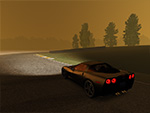
| Home | Watch the world in 3D. |

|
|
|
Introduction
This article was written for Racer v0.9.0RC7, where the Oculus Rift Development Kit glasses are supported. The future consumer edition may prove to require changes though; this article just explains how to get it working in Racer as it stands.
The development kit comes with a 1280x800 display.
There is a fully configured version of Racer v0.9.0.RC7 here (150Mb).
SetupGetting the Rift to work in Racer takes a bit of work, as it is not supported natively with a nice user interface around it. Here are the steps you need to take:
global
{
free_shifting=0
name=Racer controls - defined ingame by menu
} controllers
{
oculus_rift
{ enable=1 time_per_update_in=1 time_per_update_out=10 ; Latency correction (in seconds) prediction_time=0.06 head_tracking { enable=1 } } mouse { ... }
Make sure the Rift is the primary monitor for vsync to work. If you duplicate/clone your desktop monitor with the Rift's display, one of the two displays will be 'leading' when using vsync. Make sure the Oculus Rift is vsyncing correctly; if not, try making it the Primary monitor and cloning the Rift's display to your desktop monitor (this worked for me).
Live parameter tuning
While Racer is running, you can modify the system setting 'scenegraph.renderer.eye_distance' to modify the eye separation. Somehow currently it seems you may need something like 0.01 (instead of an expected 0.06 for 6 cm) to keep it together.
Also, you can use the system to tune the latency prediction by commands as 'set controllers.oculus_rift.prediction_time 0.06'. Try values between 0 and 0.1; more will become jittery and not nice to the brain!
Notes
Note that future Rift models may require shader changes (lens center etc). Currently these are hardcoded in the fullscreen shader (oculus_rift_f.cg).
Hopefully the Rift's future will see improved resolution (2 or 3-fold at least) and positional tracking.
(last updated May 24, 2013 )